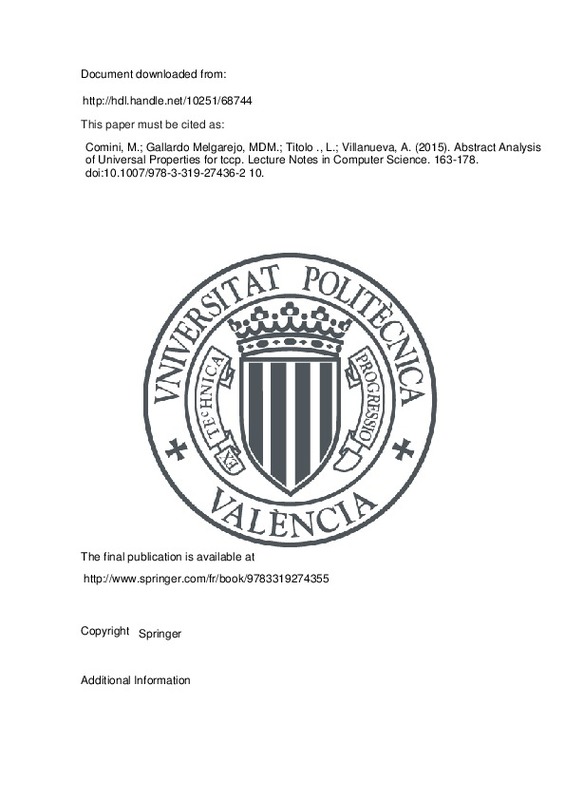JavaScript is disabled for your browser. Some features of this site may not work without it.
Buscar en RiuNet
Listar
Mi cuenta
Estadísticas
Ayuda RiuNet
Admin. UPV
Abstract Analysis of Universal Properties for tccp
Mostrar el registro sencillo del ítem
Ficheros en el ítem
| dc.contributor.author | Comini, Marco
|
es_ES |
| dc.contributor.author | Gallardo Melgarejo, Maria del Mar
|
es_ES |
| dc.contributor.author | Titolo, Laura
|
es_ES |
| dc.contributor.author | Villanueva, Alicia
|
es_ES |
| dc.date.accessioned | 2016-09-05T13:48:58Z | |
| dc.date.available | 2016-09-05T13:48:58Z | |
| dc.date.issued | 2015 | |
| dc.identifier.isbn | 978-3-319-27435-5 | |
| dc.identifier.issn | 0302-9743 | |
| dc.identifier.uri | http://hdl.handle.net/10251/68744 | |
| dc.description.abstract | [EN] The Timed Concurrent Constraint Language (tccp) is a time extension of the concurrent constraint paradigm of Saraswat. tccp was defined to model reactive systems, where infinite behaviors arise naturally. In previous works, a semantic framework and abstract diagnosis method for the language has been defined. On the basis of that semantic framework, this paper proposes an abstract semantics that, together with a widening operator, is suitable for the definition of different analyses for tccp programs. The abstract semantics is correct and can be represented as a finite graph where each node represents a hypothetical computational step of the program containing approximated information for the variables. The widening operator allows us to guarantee the convergence of the abstract fixpoint computation. | es_ES |
| dc.description.sponsorship | This work has been supported by the Andalusian Excellence Project P11-TIC7659. This work has been partially supported by the EU (FEDER) and the Spanish MINECO under grant TIN 2013-45732-C4-1-P (DAMAS) and by Generalitat Valenciana PROMETEOII/2015/013 | |
| dc.language | Inglés | es_ES |
| dc.publisher | Springer | es_ES |
| dc.relation.ispartof | Lecture Notes in Computer Science | es_ES |
| dc.rights | Reserva de todos los derechos | es_ES |
| dc.subject | Concurrent constraint paradigm | es_ES |
| dc.subject | Abstract analysis | es_ES |
| dc.subject.classification | LENGUAJES Y SISTEMAS INFORMATICOS | es_ES |
| dc.title | Abstract Analysis of Universal Properties for tccp | es_ES |
| dc.type | Artículo | es_ES |
| dc.type | Comunicación en congreso | es_ES |
| dc.identifier.doi | 10.1007/978-3-319-27436-2_10 | |
| dc.relation.projectID | info:eu-repo/grantAgreement/Junta de Andalucía//P11-TIC7659/ | es_ES |
| dc.relation.projectID | info:eu-repo/grantAgreement/MINECO//TIN2013-45732-C4-1-P/ES/UNA APROXIMACION DECLARATIVA AL MODELADO, ANALISIS Y RESOLUCION DE PROBLEMAS/ | es_ES |
| dc.relation.projectID | info:eu-repo/grantAgreement/GVA//PROMETEOII%2F2015%2F013/ES/SmartLogic: Logic Technologies for Software Security and Performance/ | es_ES |
| dc.rights.accessRights | Abierto | es_ES |
| dc.contributor.affiliation | Universitat Politècnica de València. Escola Tècnica Superior d'Enginyeria Informàtica | es_ES |
| dc.description.bibliographicCitation | Comini, M.; Gallardo Melgarejo, MDM.; Titolo, L.; Villanueva, A. (2015). Abstract Analysis of Universal Properties for tccp. Lecture Notes in Computer Science. 163-178. https://doi.org/10.1007/978-3-319-27436-2_10 | es_ES |
| dc.description.accrualMethod | S | es_ES |
| dc.relation.conferencename | 25th International Symposium on Logic-based Program Synthesis and Transformation (LOPSTR 2015). [Revised Selected Papers] | es_ES |
| dc.relation.conferencedate | July 13, 2015 | es_ES |
| dc.relation.conferenceplace | Siena, Italy | es_ES |
| dc.relation.publisherversion | http://dx.doi.org/10.1007/978-3-319-27436-2_10 | es_ES |
| dc.description.upvformatpinicio | 163 | es_ES |
| dc.description.upvformatpfin | 178 | es_ES |
| dc.type.version | info:eu-repo/semantics/publishedVersion | es_ES |
| dc.relation.senia | 302636 | es_ES |
| dc.contributor.funder | Junta de Andalucía | |
| dc.contributor.funder | Ministerio de Economía y Competitividad | |
| dc.contributor.funder | Generalitat Valenciana | |
| dc.description.references | Alpuente, M., Gallardo, M.M., Pimentel, E., Villanueva, A.: A semantic framework for the abstract model checking of tccp programs. Theor. Comput. Sci. 346(1), 58–95 (2005) | es_ES |
| dc.description.references | Bagnara, R., Hill, P.M., Ricci, E., Zaffanella, E.: Precise widening operators for convex polyhedra. Sci Comput. Program. 58(1–2), 28–56 (2005) | es_ES |
| dc.description.references | Comini, M., Titolo, L., Villanueva, A.: Abstract diagnosis for timed concurrent constraint programs. Theor. Pract. Log. Program. 11(4–5), 487–502 (2011) | es_ES |
| dc.description.references | Comini, M., Titolo, L., Villanueva, A.: A condensed goal-independent bottom-up fixpoint modeling the behavior of tccp. Technical report, DSIC, Universitat Politècnica de València (2013). http://riunet.upv.es/handle/10251/34328 | es_ES |
| dc.description.references | Cousot, P., Cousot, R.: Abstract Interpretation: a unified lattice model for static analysis of programs by construction or approximation of fixpoints. In: Proceedings of the 4th ACM SIGACT-SIGPLAN Symposium on Principles of Programming Languages, Los Angeles, California, January 17–19, pp. 238–252. ACM Press, New York (1977) | es_ES |
| dc.description.references | de Boer, F.S., Gabbrielli, M., Meo, M.C.: A timed concurrent constraint language. Inf. Comput. 161(1), 45–83 (2000) | es_ES |
| dc.description.references | Falaschi, M. Gabbrielli, M., Marriott, K., Palamidessi, C.: Compositional analysis for concurrent constraint programming. In: Proceedings of the Eighth Annual IEEE Symposium on Logic in Computer Science, pp. 210–221. IEEE Computer Society Press, Los Alamitos (1993) | es_ES |
| dc.description.references | Falaschi, M., Olarte, C., Palamidessi, C.: Abstract interpretation of temporal concurrent constraint programs. Theor. Pract. Log. Program. (TPLP) 15(3), 312–357 (2015) | es_ES |
| dc.description.references | Falaschi, M., Villanueva, A.: Automatic verification of timed concurrent constraint programs. Theor. Pract. Log. Program. 6(3), 265–300 (2006) | es_ES |
| dc.description.references | Saraswat, V.A.: Concurrent Constraint Programming. The MIT Press, Cambridge (1993) | es_ES |
| dc.description.references | Zaffanella, E., Giacobazzi, R., Levi, G.: Abstracting synchronization in concurrent constraint programming. J. Funct. Log. Program. 6, 1997 (1997) | es_ES |







![[Cerrado]](/themes/UPV/images/candado.png)

